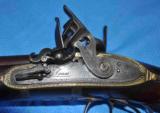 |
 |
 |
 |
 |
 |
 |
 |
 |
 |
 |
 |

Jones maker to HRH Prince Albert
Guns International #: 100626679 Seller's Inventory #:
Category: Shotguns - English Double Antique - Antique Rifles - Flintlock
Seller's Information
When emailing or calling sellers direct, please mention that you saw their listing on GunsInternational.com
Seller: DScheeres
Company: Pembroke Fine Arms
Member Since: 8/11/08
First Name: David
Last Name: Scheeres
State: State not Found
Country: United States
Phone: 011-44-164-668-9900 FROM USA
Total Number of Listings: 7
Seller: Private Seller
Return Policy: 3 day inspection and return policy on used guns.
GUNS LOCATED IN USA
Payment Types Accepted: Bank transfer USPS MO's Checks
Description:
I offered this gun last year and thought I had a buyer but it fell through as I hauled it to Tulsa but he didn’t turn up so I have decided to offer it again at a reduced price. I travel to the USA at least four times a year and will exhibit it at Tulsa this weekend and the Big Reno Show next weekend if you would like to see it. This is unique and I am happy to show it you and explain it to even if you aren’t going to buy it. This is worth looking at!
This is an extraordinary and rare shotgun that was made circa 1835 with a dual ignition system so can be regarded as the epitome of transitional shotguns. The lock features both percussion nipples and a flintlock these can be selected to fire flintlock, percussion or both by moving an interrupter switch which can isolate the platinum lined touch hole in the flash pan. By moving this switch you can fire the gun as a percussion only or flint only or with both systems together. Overall length is 45" with a barrel length of 29" with a bore measuring .6" so approximately 20 bore. The bores are mirror bright and have been well looked after. The gun has many quality features which includes the original ebony brass tipped ramrod, foliate engraving and barley corn brass surrounds on the lock, a lanyard ring on the forend key and fine featured English walnut stock. Each individual screw head is also engraved as can be seen from the images.
Locks are marked "Jones" and the overall quality is excellent and the gun has not been messed around with. There is one small contemporary repair to the butt which was clearly made during its short working life but not a significant detraction to the overall appearance of the gun. I assume that the gun was made for somebody who intended travelling overseas at the time it was made and who was concerned that he would not be able to purchase percussion caps overseas. Another theory is that the person using the gun wanted “belt and braces” and wanted to make sure that when he pulled the triggers, the gun fired!
Here is a history of the man who made this gun.
Charles Frederick Jones was the son of John Jones of Manor Row, Tower Hill (an armourer in the Hudson's Bay Company from 1785-1793). Charles was born in about 1800, and in 1814 was apprenticed to John Mason. He became a Freeman of the Gunmakers Company (by patrimony?) in 1822. He was recorded in business at "Near the Helmet", St Katherine's, as a gun and pistol maker in 1822, and it seems his brother, Frederick William, joined him soon after the business was established.
He was not recorded again until 1829 when, probably in addition to the St Katherine's premises, he had an address in Pennington Street, Ratcliff Highway. At this time his brother left to set up his own business.
In 1831 he opened a factory in Birmingham at 16 Whittall Street.
In 1832 he was recorded at 26 St James's Street and was the neighbour to James Purdey.
On 7 March 1833 he patented a percussion lock with a cock, tumbler and trigger made in a single curved piece (concentric sears and triggers), and a waterproof sliding cover (No. 6394 in the UK but also patented France), and on 12 June 1833 an improvement with separate triggers and sears (No. 6436). The caps of these Jones patent guns fitted on to the hammer noses and had the fulminate on the outside. This system was called centre-fire, and they struck the nipple and ignited the powder in the chamber.
In 1838 Charles Jones described himself as a "Patent and General Gunmaker", and later as a gun manufacturer. At about this time the firm had a shop at 32 Cockspur Street.
There is no record of the firm in London after 1845, and the Birmingham factory may have closed in 1843, but Charles Jones was a member of the Acadamie de L'Industrie de France and the firm may have traded after 1845.
Jones had premises in London and Birmingham and was appointed as Gunmaker to HRH the Prince Albert, Queen Victoria’s husband. Amongst a number of patents, one of Jones' patents was for an isolation switch to waterproof a flashpan as explained above and I dare say this stunning gun is a derivative of that work. Renowned British Gunsmith Peter Dyson believes the brass bolsters were fitted because the maker was worried about sideways expansion if both methods of ignition were used simultaneously. You have to appreciate that at this time percussion caps were revolutionary and a cautious gunsmith would have been concerned about his customer firing two ignition systems at the same time.
This is a rare and significant gun and as I said to someone recently, if I was asked to source a choice Purdey or Boss shotgun I could find several if not dozens within the week but to find a unique antique double ignition system firearm of this quality would be impossible to find. This would make an extraordinary and unique addition to any fine gun collection.
SOLD
Manufacturer: Jones
Model: Dual Ignition or "Flintcussion
Bore: 20 bore
Metal Condition: Excellent
Wood Condition: Excellent for age
Bore Condition: Bright
Triggers: Double
Manufacture Date: 1835
Engraving: Foliate
Extras: Brass bolsters
Item Location: See Ad
Minimum Wall Thickness Left: Well in proof
Minimum Wall Thickness Right: Well in proof